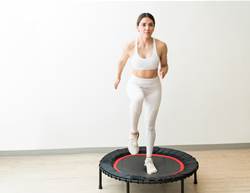Nearly half of Australians with a job described their day at work as “mostly sitting”, according to Better Health Victoria. And even if we have an active job, much of our free time is spent sitting, whether that’s scrolling on Instagram or watching TV.
A global study by ASICS shows that our mental state starts to decline after only two hours of continuous desk-based working, with stress levels rising significantly after four hours.
It’s not just our stress levels that take a hit with a sedentary lifestyle. Not getting enough exercise is a major risk factor for many chronic health conditions, according to the Australian Institute of Health & Welfare. It puts you at greater risk of heart disease, type 2 diabetes, osteoporosis and dementia. Being active not only improves your mental health, it reduces your risk of high blood pressure, high cholesterol and being overweight.
The good news on stress at work
So, we get it. Sitting is bad for our health. The good news? Just 15 minutes of exercise a day can help to reverse the effects.
That’s the takeout from ASICS research overseen by exercise and mental health researcher Dr Brendon Stubbs from King’s College London; when office workers added just 15 minutes of movement into their working day, their mental state improved by a whopping 22%. Even your boss should be on board with this one: taking daily exercise breaks for one week not only lowered stress levels by 14%, but it also boosted productivity by 33% and improved focus by 28%.
“We have shown previously that just 15 minutes of exercise in leisure time can result in a meaningful improvement in people’s State of Mind scores. But what surprised us with [this] experiment was how powerful the 15 minute movement breaks were in improving wellbeing and reducing stress. It even changed people’s perceptions of their workplace for the better,” says Dr Stubbs.
How to incorporate “exercise breaks” into your day
You don’t need to go hard at the gym for hours to get exercise into your day. An Australian study from the University of Sydney found that even one-minute bursts of intense activity performed three or four times a day can boost overall health to reduce the risk of premature death by up to 40%. Any movement counts but it helps to include all types of movement, including cardio, strength and stretching.
We spoke to two fitness experts to get their top tips for fitting in short bursts of exercise into your day.
1. Use waiting time well
“Make the most of ‘waiting time’,” says ASICS running expert Sam Hopper. “For example, do calf raises while you wait for your lunch to heat in the microwave, while you wait for the kettle to boil, or your tea to steep.”
2. Walk and talk
To get more exercise breaks at work, get others involved in your mission to move more. “For any internal meetings, ask if you can do a walk-and-talk instead of sitting at your desk. Likewise, and phone calls you need to make is also an easy way to incorporate exercise into your day,” says Hopper.
3. Make habits exercise reminders
Add in movement to tasks you do regularly, using them as a reminder to move. “For example, every time you go to the bathroom add in a few squats, or when you fill up your water bottle do a few stretches, it’s a good way to ensure you’re moving frequently,” says Hopper.
4. Get up early
Start off your day on the right foot, advises personal trainer Emily Skye.
“Set your morning alarm 30 minutes earlier than you normally would and use those 30 minutes to move your body. Exercising first thing in the morning can create a positive mindset for the rest of the day and using that extra half hour in the morning means it’s done before you’d normally wake up!”
Get your exercise clothes ready the night before so it’s easy to just get up and go.
5. Actually take a lunch break
When lunch time comes around, don’t just work through your break, says Skye.
“Use your work lunch break to go on a light walk. Not only is this a great chance to get some extra steps in, but it also allows you to step away from your work environment, breathe in some fresh air and reset your mind, which is great for managing stress,” she says.
6. Get the family in on the act
If you’re a parent, get the whole family moving in the evenings and on the weekend.
“Combine family time with fun activities to get everyone involved. This can be as simple as a 10-minute backyard game of soccer with the kids or going on a bike ride around the neighbourhood. It gets everyone moving and doesn’t require much equipment or time,” says Skye.
7. Clean harder
Even cleaning can be an opportunity to get your heart rate up, says Skye.
“Use everyday household chores as an excuse to exercise. Many household chores can already be physically demanding, like vacuuming, gardening, washing the car, just to name a few. Make them more active by doing them at pace and with purpose.”
Think that doesn't count? Just half an hour of cleaning burns around 444kJ.
Want more? Read Making Lunch Break Exercise Work for You and 13 Everyday Activities That Sneak More Exercise Into Your Day.









